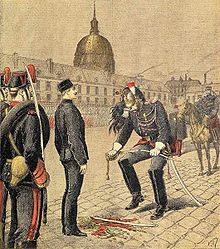- Cashiering
-
This article is about the military term. For the occupation, see Cashier.
 On January 5, 1895, Captain Alfred Dreyfus being cashiered.
On January 5, 1895, Captain Alfred Dreyfus being cashiered.
Cashiering (sometimes referred to as a degradation ceremony, although that term may be used more generally in sociology) is a ritual dismissal of an individual from some position of responsibility for discipline.
It is especially associated with the dismissal of military officers of high rank. Cashiering sometimes involved public degradation, with the destruction of symbols of status: epaulettes ripped off shoulders, badges and insignia stripped, swords broken, caps knocked away, and medals torn out and dashed upon the ground.
In addition, in the era when British Army officers generally bought their commissions, being cashiered meant that the amount they had paid was lost, as they could not "sell-out" afterwards.[1]
Cashiering is associated with stigmatisation and disgrace. The phrase degradation ceremony was applied by sociologist Harold Garfinkel to any act of public communication whose intent is to stigmatise the subject(s) as being unworthy of the normal privileges of their previous role in a society or institution.
Famous victims of cashiering include Alfred Dreyfus (see trial and conviction of Alfred Dreyfus and Dreyfus affair), Philippe Pétain, Thomas Cochrane, 10th Earl of Dundonald (after the Great Stock Exchange Fraud of 1814), and Francis Mitchell.
In fiction
Cashiering is mentioned in Rudyard Kipling's poem "Danny Deever", in which a British soldier in India is cashiered before being hanged for murder.
In the cartoon Fresh Hare, Bugs Bunny is being chased by Elmer Fudd, in this case an officer with the Royal Canadian Mounted Police. Bugs impersonates a senior officer and cashiers Elmer, not only tearing off his insignia and decorations but also his buttons and the rest of his uniform, even his undershorts
In the movie "Mary Poppins" when a British banker is fired, a version of cashiering occurs: the members of the bank's board of directors ceremoniously destroy the banker's hat, suit and umbrella before showing him the door.
See also
- Demotion
- Drumming out
- Dishonorable discharge
- Military discipline
- Political rehabilitation
References
- ^ Holmes, Richard (2001) [2001]. "Chapter III - Brothers of the Blade". Redcoat: the British soldier in the age of horse and musket (Hardback ed.). London: HarperCollins. p. 159. ISBN 0-00-257097-1.

This military-related article is a stub. You can help Wikipedia by expanding it.
